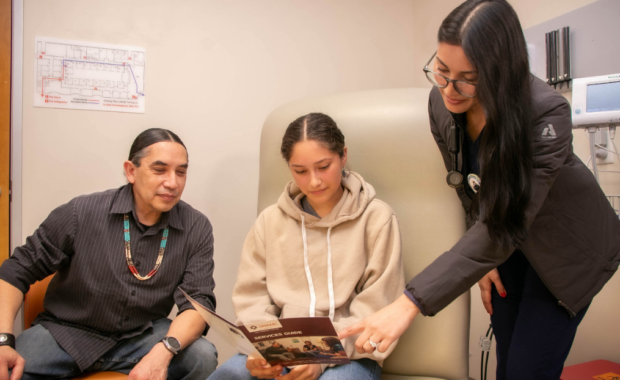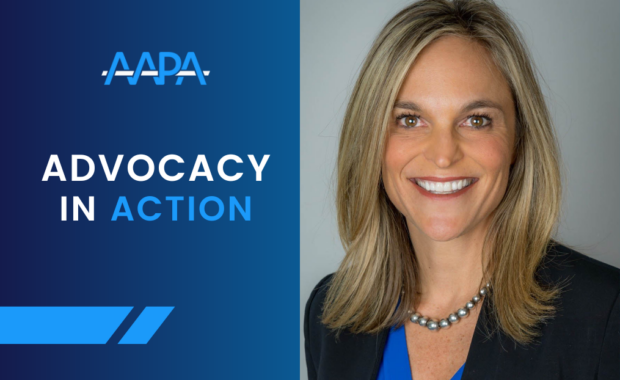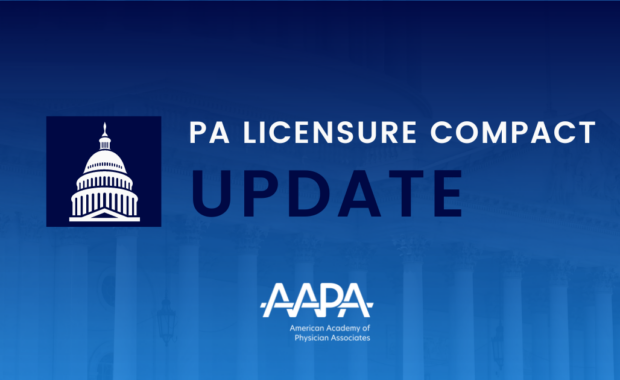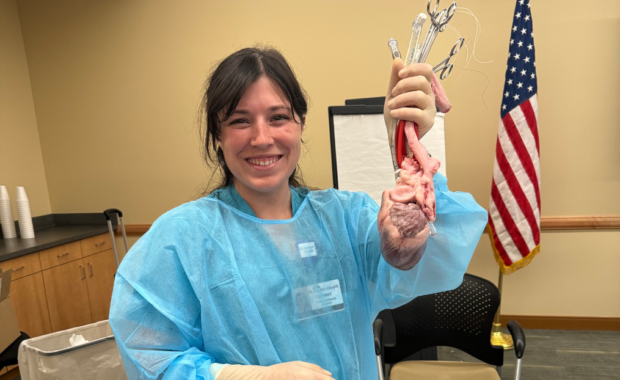PA Audrey Smeenk Helps Rural Community Navigate COVID-19 Challenges
SDAPA President Encourages Fellow PAs to Speak Up “Loud and Proud” for the Profession
October 31, 2023
By Katy Shenk
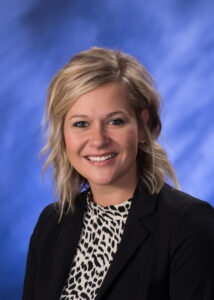
Audrey Smeenk, PA-C, knew she wanted to work in healthcare after shadowing her first PA: her mother. As a young child, Smeenk trailed her throughout the hospital and witnessed her compassion and dedication to caring for patients – from running a trauma code in the ED to consoling a hospice patient and their family members. From a young age, she witnessed the versatility of PAs’ skillset and scope of practice, which she admired. With the initial goal of becoming a flight nurse, Smeenk began her career as an LPN and later an RN, practicing in an adult ICU and as a float pool nurse, which allowed her to gain experience in multiple departments.
Working as a flight nurse was a “dream job” for Smeenk, who valued the opportunity to be a resource for rural facilities and provide care for their most vulnerable patients. In this position, and from having grown up in a rural community, she realized the extreme need for providers in rural areas and decided to advance her career as a PA.
Working in Small-Town South Dakota during the Pandemic
Currently, Smeenk works as a PA in Philip, South Dakota, a rural town with 759 residents. Though small, the Philip Health Services clinic serves a large region of western South Dakota where access to medical resources is sparse. “You could say we are the real definition of ‘rural critical access’ medicine,” she says.
While living in such a small town isn’t for everyone, Smeenk chose Philip for several reasons. After growing up in rural South Dakota, Smeenk says she’s accustomed to doing without fast-food restaurants, Target, and other conveniences – although she does miss them sometimes. Mainly, it was a past rural medicine and family practice preceptorship in Philip that drew her attention to this small-town community, and she’s found enjoyment in the unique challenges and autonomy that accompany rural healthcare.
“Practicing medicine here is truly a one-of-a-kind experience, and you rely significantly on your assessment skills and the little resources you have. This type of medicine really allows you to practice all aspects of healthcare: You may be doing some internal medicine, an OB visit, setting a dislocated fracture, and completing a skin biopsy procedure all in the same day,” she says. Adding to this challenge is the limited availability of nearby specialists, which requires Smeenk and her fellow providers to be highly knowledgeable about complex acute and chronic diseases.
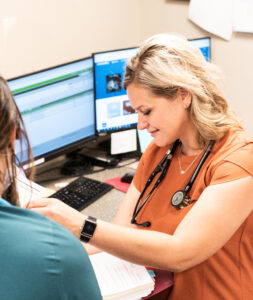
The early stages of the COVID-19 pandemic – which Smeenk stepped into as a recently-graduated PA – exacerbated these complexities and nuances of rural healthcare. She was called upon immediately to master the expectations of the clinic, the critical access hospital, a busy rural ED, and two nursing homes.
“To say I had no idea what I’d gotten myself into was an understatement. Every second of the day consumed me with trying to learn more and figure out how to effectively take care of the patients I was caring for,” she says.
Struggling to manage sick patients, train new staff, and accommodate daily changes in COVID-19 management recommendations, Smeenk found herself drained, burned out, and even questioning her career choice.
“I had this new sense of anxiety that I have never experienced before; I had no time for self-care,” she says. She survived, she recalls, through the constant encouragement of her physician mentors, her healthcare team, her family, and the support of her community.
Advocating for Mental Healthcare
Even in navigating her own mental health struggles, Smeenk has found ways to center her patients, finding that her own experiences with depression and anxiety often allow her to empathize with those seeking mental healthcare. She is also working to dismantle the stigma associated with mental health, which she continues to observe in her community.
“I counsel my patients on mental health being a chronic issue, just like hypertension or hypercholesterolemia. If they came into the clinic with high blood pressure, I’d treat that, so why is there so much resistance to treating mental health?” she says.

Smeenk also advocates for behavioral health telemedicine services – which were recently made available through Philip Health Services – that can connect patients to a broader network of behavioral health professionals and improve patients’ access to care. While she appreciates the close-knit community of Philip, she also realizes that the potential to run into a counselor downtown or be seen by a mental health provider who is a family friend may deter patients from seeking the help they need. “These are the extra unique struggles of small-town medicine,” she says, hoping that behavioral telehealth may mitigate these concerns.
Smeenk knows that providers like herself who go above and beyond for their patients often struggle to maintain a work-life balance or find the time to prioritize their own mental health. She’s further concerned that current practices discourage providers from being forthcoming about mental health struggles.
“It’s frustrating to me that as a PA or medical provider, when I go to get my license, if I check the box that says I have dealt with any sort of mental health issues in the past I need to explain further or have a note saying I’m physically fit for my job. I should be able to admit I struggled during a pandemic without feeling inadequate,” she says. She encourages fellow PAs to reach out to one another for support, reiterating the importance of relationships with mentors and the encouragement of her team.
Paving the Way for Future PAs
Above all else, Smeenk puts listening to, caring for, and building relationships with patients at the center of her practice. She sees these values as vital to practicing medicine and core tenants of being a PA. As the recently elected President of the South Dakota Academy of PAs (SDAPA), she’s eager to spread the word about PA value.
“More than ever, we as PAs need to speak up, loud and proud for our profession. I want to ensure our profession is adequately represented and demonstrate the competency and efficiency we have as PAs,” she says. In her new leadership role, she also hopes to encourage her fellow South Dakota PAs to become more involved in state advocacy and give testimony to the quality care PAs provide.

Unsurprisingly, her favorite part of being a PA is the patients and community she serves in Philip. She appreciates her ability to care for patients in multiple capacities, which she feels uniquely equipped to do as a PA – especially in a rural healthcare setting.
“I love this about my position right now – I can go from managing a critical care or trauma patient in the ED to taking on the challenge of managing an internal medicine patient, to celebrating the milestones of a pregnancy with a pregnant woman,” she says.
Besides “PA,” Smeenk’s other favorite title is mom, and she enjoys sharing time outdoors with her 6-year-old daughter, Addley. While the demands of her position sometimes make it hard to balance work and family, she’s thankful to be able to exemplify the value of hard work and her love for medicine with her daughter – just as her mother once shared with her.
Editor’s Note: This article was originally published in October, 2022
You May Also Like
Improving Access to Healthcare in Alaska’s Rural Villages
PA Week 2022 Kicks off With PAs on Not One, but Two Morning Show Plazas
From Practicing in War Zones to Remote Islands, Melinda Rawcliffe Finds Endless Opportunities as a PA
Thank you for reading AAPA’s News Central
You have 2 articles left this month. Create a free account to read more stories, or become a member for more access to exclusive benefits! Already have an account? Log in.
